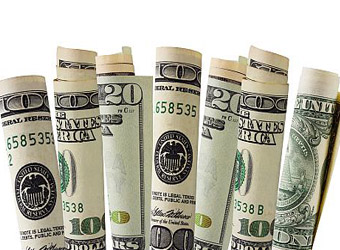The dollar sagged against the yen on Thursday, weighed down by U.S. yields slipping to two-week lows and an ebb in risk appetite that favored the safe-haven Japanese currency.
The dollar was down 0.4 percent at 116.800 yen, having come down from a high of 117.815 touched overnight.
Treasury yields fell in the wake of weaker-than-expected U.S. pending home sales data and a robust debt auction.
The greenback also felt pressure from the safe-haven yen, which provided a home for funds retreating from the region’s riskier assets.
The euro was given breathing space as the dollar weakened against its Japanese peer. The common currency was up 0.2 percent at $1.0437 after falling to as low as $1.0372 the previous day.
“The dollar looks like it has run its course against the yen for now. But against the euro, the dollar still has room to gain as the pair is now trying to catch up to the widening between U.S. and German yields,” said Masafumi Yamamoto, chief forex strategist at Mizuho Securities in Tokyo.
The spread between the 10-year U.S. Treasury and German bund yields is the widest on record stretching back to 1990.
The spread has been increasing recently on the divergence between European and U.S. central bank policy and outlooks for growth and inflation.
The common currency already hit a near 14-year low of $1.0352 last week and analysts expect it to eventually reach parity with the dollar next year. The euro has fallen 3.8 percent this year.
The dollar index was down 0.2 percent at 103.080, but still in reach of a 14-year high of 103.650 struck last week. The index has gained 4.4 percent this year, the bulk of the rise taking place after the U.S. elections early in November.
The index has climbed on expectations that Donald Trump’s incoming administration will boost U.S. growth through fiscal stimulus, which could be accompanied by monetary tightening and higher yields.
Against the yen, the dollar was en route for a loss of nearly 3 percent in 2016, although it has rallied more than 10 percent since Trump’s election victory.
“While the market collectively may not be focusing on the story, dollar strength could become a domestic political issue in 2017 should it persist,” wrote strategists at BNY Mellon.
“Should the dollar make substantial gains from here, particularly against the yen, it will be interesting to see how president-elect Trump responds given his previous comment.”
Trump earlier in the year had criticised Japan, along with China and Mexico, saying Tokyo has deliberately lowered the yen’s value against the dollar.
Sterling was up 0.1 percent at $1.2239. The pound was still in reach of a two-month low of $1.2201 set overnight amid fresh uncertainty over Britain’s Brexit negotiations.
The currency, dogged by Britain’s mid-year decision to leave the European Union, hit a three-decade trough below $1.1500 in October and was on track to lose 17 percent in 2016.
The Australian dollar was up 0.25 percent at $0.7195. The Aussie was headed for a decline of 1.2 percent on the year against a broadly stronger dollar.
The New Zealand dollar fared a little better, having risen 1.4 percent this year. While the kiwi lost steam towards the year’s end against the rampant dollar, it benefited from New Zealand’s sound economic growth and relatively higher interest rates.
Source: Reuters


